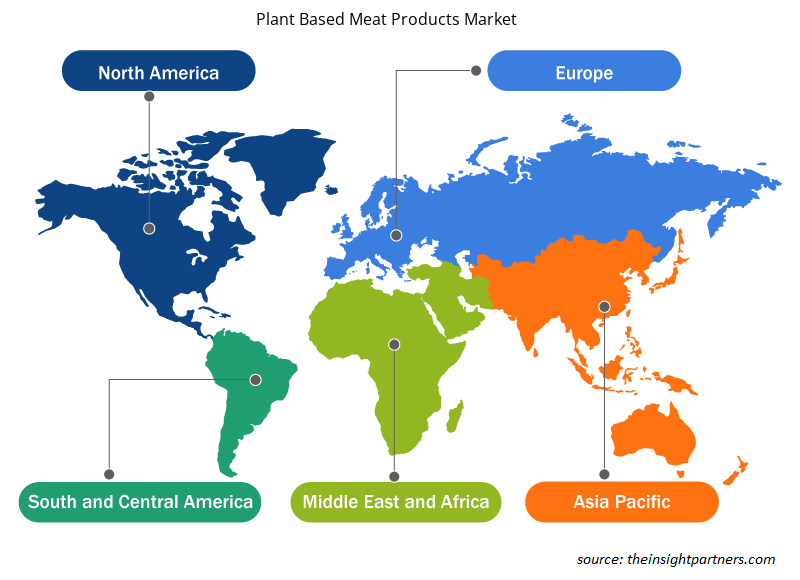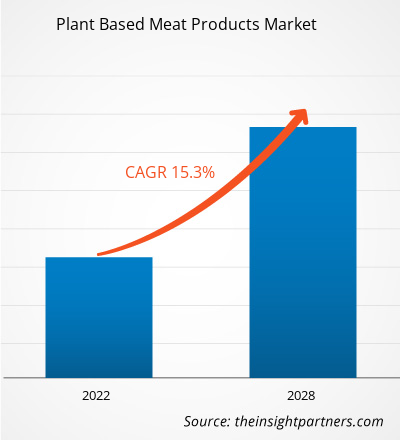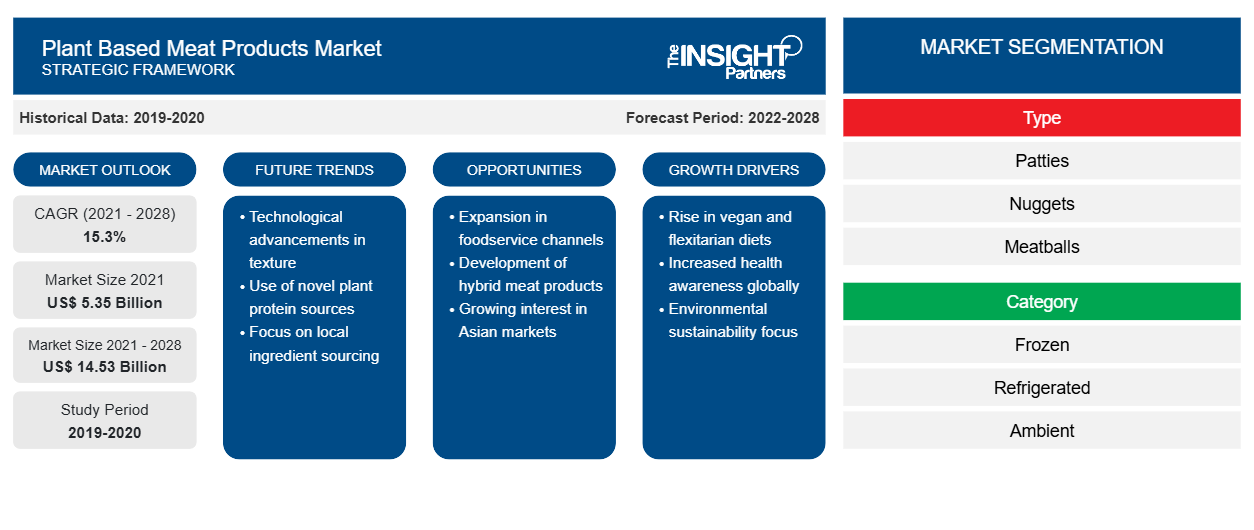[Rapporto di ricerca] Si prevede che il mercato dei prodotti a base di carne di origine vegetale raggiungerà 14.527,55 milioni di dollari entro il 2028, rispetto ai 5.354,72 milioni di dollari del 2021; si prevede che crescerà a un CAGR del 15,3% dal 2021 al 2028.
Approfondimenti di mercato e opinioni degli analisti:
I prodotti a base di carne di origine vegetale sono realizzati utilizzando proteine vegetali come proteine di soia, proteine di piselli e proteine di grano. Le proteine di soia sono ampiamente utilizzate per realizzare prodotti a base di carne di origine vegetale in quanto sono più convenienti di altre proteine vegetali e forniscono una consistenza ideale ai prodotti, simile ai prodotti a base di carne animale convenzionali. Polpette, bocconcini, salsicce e polpette sono alcuni dei prodotti a base di carne di origine vegetale più comuni disponibili sul mercato. I consumatori sono molto propensi a prodotti a base vegetale o vegani a causa delle crescenti preoccupazioni per la salute e della crescente consapevolezza riguardo al benessere degli animali. La crescente consapevolezza della salute tra le persone a causa della crescente prevalenza di obesità, diabete e altre malattie sta spingendo le persone a cambiare le proprie abitudini alimentari. Le persone generalmente percepiscono i prodotti a base vegetale come più sani dei prodotti convenzionali di origine animale. Questo fattore sta guidando in modo significativo la crescita del mercato dei prodotti a base di carne di origine vegetale
Fattori di crescita e sfide:
I prodotti a base di carne vegetale contengono meno grassi saturi e calorie rispetto ai prodotti a base di carne convenzionali, il che li rende una scelta più sana. Questo fattore sta guidando la crescita del mercato dei prodotti a base di carne vegetale. L'ascesa della tendenza al veganismo è anche attribuita alla crescente empatia verso gli animali. La crescente consapevolezza riguardo al maltrattamento degli animali nei macelli e nelle fabbriche ha sollevato preoccupazioni sulla protezione degli animali tra i consumatori. Si prevede inoltre che questo fattore incrementerà il consumo di alimenti a base vegetale, guidando il mercato dei prodotti a base di carne vegetale. Tuttavia, il suo prezzo elevato ne limita l'adozione tra i consumatori sensibili al prezzo. Nelle principali catene di supermercati, come Kroger e Walmart, due hamburger a base vegetale di Beyond Meat possono essere acquistati per circa 5,99 $ USA. D'altra parte, 2 libbre di carne macinata sono disponibili a circa lo stesso prezzo, il che potrebbe produrre 10 volte più hamburger. Pertanto, dopo aver confrontato i prezzi, i consumatori generalmente finiscono per acquistare carne convenzionale invece di carne a base vegetale, il che rappresenta un ostacolo alla crescita del mercato dei prodotti a base di carne vegetale . I produttori si stanno concentrando sul raggiungimento di economie di scala per ridurre il costo complessivo richiesto per la produzione di prodotti a base di carne vegetale. Tale iniziativa potrebbe aiutare i produttori ad acquisire nuovi clienti anche nei mercati sensibili al prezzo.
Personalizza questo report in base alle tue esigenze
Riceverai la personalizzazione gratuita di qualsiasi report, comprese parti di questo report, o analisi a livello nazionale, pacchetto dati Excel, oltre a usufruire di grandi offerte e sconti per start-up e università
-
Scopri le principali tendenze di mercato in questo rapporto.Questo campione GRATUITO includerà analisi di dati che spaziano dalle tendenze di mercato alle stime e alle previsioni.
Segmentazione e ambito del report:
Il "mercato globale dei prodotti a base di carne a base vegetale" è segmentato in base a tipo, categoria, canale di distribuzione e area geografica. In base al tipo, il mercato dei prodotti a base di carne a base vegetale è segmentato in polpette, nugget, polpette, salsicce e altri. In base alla categoria, il mercato dei prodotti a base di carne a base vegetale è segmentato in surgelati, refrigerati e a temperatura ambiente. In base al canale di distribuzione, il mercato dei prodotti a base di carne a base vegetale è segmentato in supermercati e ipermercati, minimarket, vendita al dettaglio online e altri. Il mercato dei prodotti a base di carne a base vegetale in base all'area geografica è segmentato in Nord America (Stati Uniti, Canada e Messico), Europa (Germania, Francia, Italia, Regno Unito, Russia e resto d'Europa), Asia Pacifico (Australia, Cina, Giappone, India, Corea del Sud e resto dell'Asia Pacifico), Medio Oriente e Africa (Sudafrica, Arabia Saudita, Emirati Arabi Uniti e resto del Medio Oriente e Africa) e Sud e Centro America (Brasile, Argentina e resto del Sud e Centro America)UAE, and Rest of Middle East & Africa), and South & Central America (Brazil, Argentina, and Rest of South & Central America)
Analisi segmentale: Analysis:
In base al tipo, il mercato dei prodotti a base di carne vegetale è segmentato in polpette, nugget, polpette, salsicce e altri. Nel 2021, il segmento delle polpette deteneva la quota maggiore nel mercato dei prodotti a base di carne vegetale.
In base al canale di distribuzione, il mercato dei prodotti a base di carne vegetale è suddiviso in supermercati e ipermercati, minimarket, vendita al dettaglio online e altri. Il segmento supermercati e ipermercati ha detenuto la quota di mercato maggiore nel 2021 e si prevede che il segmento della vendita al dettaglio online registrerà il CAGR più elevato nel periodo di previsione. La vendita al dettaglio online è uno dei canali di distribuzione in più rapida crescita grazie alla sua praticità in termini di acquisto e consegna dei prodotti. I negozi al dettaglio online offrono un'ampia varietà di prodotti con forti sconti; inoltre, i consumatori possono acquistare comodamente prodotti desiderabili da remoto. Il servizio di consegna a domicilio attrae un vasto gruppo di clienti ad acquistare tramite una piattaforma di e-commerce. I siti Web di e-commerce offrono informazioni dettagliate sui prodotti, insieme alle recensioni degli utenti, che aiutano gli acquirenti a confrontare i prodotti e prendere decisioni informate. Questi fattori stanno guidando in modo significativo la crescita del segmento nei prossimi anni.CAGR over the forecast period. Online retail is one of the fastest-growing distribution channels owing to its convenience in terms of shopping and product delivery. Online retail stores offer a wide variety of products with heavy discounts; also, consumers can conveniently buy desirable products remotely. Home delivery service attracts a large group of customers to shop through an e-commerce platform. E-commerce websites offer detailed product information, along with user reviews, which help buyers compare products and make informed decisions. These factors are significantly driving the segment’s growth over the upcoming years.
Analisi regionale:
In base alla geografia, il mercato dei prodotti a base di carne di origine vegetale è suddiviso in cinque regioni chiave: Nord America, Europa, Asia Pacifico, Sud e Centro America e Medio Oriente e Africa. Le dimensioni del mercato globale dei prodotti a base di carne di origine vegetale per l'Europa hanno rappresentato 2.060,30 milioni di dollari nel 2021. Il Nord America è un secondo importante contributore che detiene una quota di oltre il 30% nel mercato globale. L'Asia Pacifico è anche uno dei mercati chiave per i prodotti a base di carne di origine vegetale che crescono a un CAGR di ~ 15%. I consumatori sono molto inclini verso i prodotti a base vegetale a causa della crescente consapevolezza riguardo al benessere degli animali. I benefici degli alimenti proteici senza colesterolo, con una consistenza simile alla carne, promuovono la crescita del mercato dei prodotti a base di carne di origine vegetale in Europa. Inoltre, con la crescente inclinazione dei consumatori verso i prodotti a base di carne di origine vegetale, i produttori stanno adottando strategie di crescita come lo sviluppo e l'espansione del prodotto per soddisfare le crescenti richieste dei consumatori. Ad esempio, Plant & Bean ha aperto una fabbrica di carne di origine vegetale a Boston e Lincolnshire (Regno Unito) nel dicembre 2020 per servire il mercato europeo. La capacità originaria di questa fabbrica era di produrre 55.000 tonnellate di carne di origine vegetale all'anno.
Sviluppi del settore e opportunità future:
Di seguito sono elencate le varie iniziative intraprese dai principali attori che operano nel mercato dei prodotti a base di carne di origine vegetale:
- Nel dicembre 2022, United Supermarket Holdings, Inc. ha lanciato "BEYOND BEEF", un'alternativa vegetale alla carne creata da Beyond Meat, Inc. BEYOND BEEF è un'alternativa vegetale alla carne macinata convenzionale, simile alla carne di manzo macinata, che può essere utilizzata come ingrediente in una varietà di piatti come hamburger, polpette e altri.
- Nell'ottobre 2022, Licious, un'azienda con sede in India, ha lanciato il marchio di carne a base vegetale "UnCrave", che comprende nel suo portafoglio kebab di carne di pollo e montone a base vegetale.
- Nel marzo 2022, Beyond Meat e PepsiCo hanno costituito una joint venture denominata "Planet Partnerships LLC" con il lancio della carne secca Beyond Meat realizzata con ingredienti 100% vegetali come piselli e fagioli mungo.
Approfondimenti regionali sul mercato dei prodotti a base di carne a base vegetale
Le tendenze regionali e i fattori che influenzano il mercato dei prodotti a base di carne a base vegetale durante il periodo di previsione sono stati ampiamente spiegati dagli analisti di Insight Partners. Questa sezione discute anche i segmenti e la geografia del mercato dei prodotti a base di carne a base vegetale in Nord America, Europa, Asia Pacifico, Medio Oriente e Africa e America meridionale e centrale.

- Ottieni i dati specifici regionali per il mercato dei prodotti a base di carne vegetale
Ambito del rapporto sul mercato dei prodotti a base di carne vegetale
| Attributo del report | Dettagli |
|---|---|
| Dimensioni del mercato nel 2021 | 5,35 miliardi di dollari USA |
| Dimensioni del mercato entro il 2028 | 14,53 miliardi di dollari USA |
| CAGR globale (2021 - 2028) | 15,3% |
| Dati storici | 2019-2020 |
| Periodo di previsione | 2022-2028 |
| Segmenti coperti |
Per tipo
|
| Regioni e Paesi coperti |
America del Nord
|
| Leader di mercato e profili aziendali chiave |
|
Densità dei player del mercato dei prodotti a base di carne vegetale: comprendere il suo impatto sulle dinamiche aziendali
Il mercato dei prodotti a base di carne a base vegetale sta crescendo rapidamente, spinto dalla crescente domanda degli utenti finali dovuta a fattori quali l'evoluzione delle preferenze dei consumatori, i progressi tecnologici e una maggiore consapevolezza dei benefici del prodotto. Con l'aumento della domanda, le aziende stanno ampliando le loro offerte, innovando per soddisfare le esigenze dei consumatori e capitalizzando sulle tendenze emergenti, il che alimenta ulteriormente la crescita del mercato.
La densità degli operatori di mercato si riferisce alla distribuzione di aziende o società che operano in un particolare mercato o settore. Indica quanti concorrenti (operatori di mercato) sono presenti in un dato spazio di mercato in relazione alle sue dimensioni o al valore di mercato totale.
Le principali aziende che operano nel mercato dei prodotti a base di carne di origine vegetale sono:
- Oltre la carne
- Marchio Conagra, Inc.
- Kellog
Disclaimer : le aziende elencate sopra non sono classificate secondo un ordine particolare.

- Ottieni una panoramica dei principali attori del mercato dei prodotti a base di carne a base vegetale
Impatto del Covid-19:
La pandemia di COVID-19 ha colpito quasi tutti i settori in vari paesi. I lockdown, le restrizioni di viaggio e le chiusure delle attività in Nord America, Europa, Asia Pacifico (APAC), Sud e Centro America (SAM) e Medio Oriente e Africa (MEA) hanno ostacolato la crescita di diversi settori, tra cui l'industria alimentare e delle bevande. Durante la fase iniziale della pandemia di COVID-19, gravi interruzioni della catena di fornitura hanno creato una carenza di materie prime, portando a un aumento dei prezzi delle materie prime. Secondo il Dipartimento dell'agricoltura degli Stati Uniti (USDA), i prezzi delle proteine dei piselli, uno degli ingredienti comuni utilizzati nella carne a base vegetale, sono aumentati a causa delle interruzioni nella catena di fornitura. Ciò ha comportato aumenti dei prezzi, con un impatto negativo sulla domanda di prodotti a base di carne a base vegetale. Tuttavia, a causa di un cambiamento significativo nelle preferenze alimentari dei consumatori, la domanda di prodotti a base di carne a base vegetale è aumentata drasticamente dopo lo scoppio del COVID-19. L'Organizzazione mondiale della sanità (OMS) ha pubblicato una linea guida sui prodotti alimentari che dovrebbero essere consumati durante la pandemia di COVID-19. La linea guida suggeriva di limitare il consumo di carne rossa a causa della sua alta percentuale di grassi saturi. Inoltre, le persone che si sono concentrate sulla riduzione del loro consumo complessivo di carne sono passate a diete vegetariane e vegane per migliorare l'immunità. Questi fattori hanno avuto un impatto positivo sulla crescita del mercato dei prodotti a base di carne di origine vegetale.
Scenario competitivo e aziende chiave:
Alcuni dei principali attori che operano nel mercato globale dei prodotti a base di carne vegetale includonoBeyond Meat; Conagra Brands, Inc.; Impossible Foods Inc.; Quorn Foods, Inc.; Kellogg Company; Hilary's Eat Well; Vbites Foods, Ltd.; Before the Butcher; Field Roast; e Tofurky; tra gli altri. Queste aziende sono fortemente coinvolte nell'innovazione di prodotto e nello sviluppo di nuovi prodotti per migliorare la loro competenza ed espandere il loro portafoglio prodotti. Inoltre, queste aziende stanno anche collaborando con altri attori del settore per soddisfare una base di clienti più ampia. Si prevede che tali iniziative forniranno un forte potenziale di crescita ai principali attori del settore che operano nel mercato dei prodotti a base di carne vegetale.
- Analisi storica (2 anni), anno base, previsione (7 anni) con CAGR
- Analisi PEST e SWOT
- Valore/volume delle dimensioni del mercato - Globale, Regionale, Nazionale
- Industria e panorama competitivo
- Set di dati Excel
Report recenti
Rapporti correlati
Testimonianze
Motivo dell'acquisto
- Processo decisionale informato
- Comprensione delle dinamiche di mercato
- Analisi competitiva
- Analisi dei clienti
- Previsioni di mercato
- Mitigazione del rischio
- Pianificazione strategica
- Giustificazione degli investimenti
- Identificazione dei mercati emergenti
- Miglioramento delle strategie di marketing
- Aumento dell'efficienza operativa
- Allineamento alle tendenze normative























 Ottieni un campione gratuito per - Mercato dei prodotti a base di carne vegetale
Ottieni un campione gratuito per - Mercato dei prodotti a base di carne vegetale